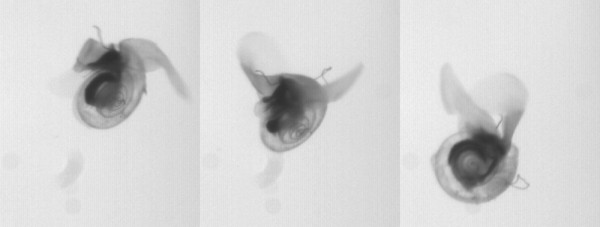By Ana Verayo, | February 19, 2016

Sea butterflies, or Limacina helicina, is a zooplankton snail that lives in cold oceans.
Snails that can fly? Only underwater of course, as these "sea butterflies" possess the uncanny ability to fly in water that is similar to the the technique of how regular insects fly via air.
These unique, tiny sea creatures are known as Limacina helicina, measuring six millimeters at most, where they use their wings that are found on each side of their shells to transport themselves through the ocean's environment. In this new study, biologists have finally figured out how these snail butterflies move across the water.
Like Us on Facebook
Researchers from the Georgia Institute of Technology carefully examined these marine snails as the tiny creatures went about their daily activities in their natural habitat. The team developed a system to monitor the snails' movement and how fluid interacted with these creatures as they propel themselves underwater.
The results revealed that these snails apparently propel their wings in a figure eight pattern that is also similar to the mechanism of how insects travel through the air.
Scientists also say that sea butterflies are rare, making them also fragile creatures where researchers find it challenging to observe these tenuous animals. In order to observe these mollusks, they were shipped across the United States to the research facility in Georgia where they were then placed inside a tank of water.
Inside the tank of water, there is a V-shaped tube found at the bottom of the tank for researchers to observe the flying snails go through the tube before the water conditions became unsuitable for the mollusks. The tiny snails completed four rounds across the camera during the observation period.
According to David Murphy of the Georgia Institute of Technology, this study involved a type of free swimming experiment where the snails are expected to complete 30 passes across the camera to obtain three usable ones. Luckily, the animals cooperated well as they demonstrated different swimming orientations, in order to provide different perspectives.
The results of the experiment revealed that the aquatic snails move their tiny wings in a figure eight similar to how fruit flies go through mid air. With each stroke, the wings touch each other to provide a boost on each wingtip. With this motion, this produces a low pressure area above the snails that make them more buoyant.
This new study is published in the Journal of Experimental Biology.
-
Use of Coronavirus Pandemic Drones Raises Privacy Concerns: Drones Spread Fear, Local Officials Say

-
Coronavirus Hampers The Delivery Of Lockheed Martin F-35 Stealth Fighters For 2020

-
Instagram Speeds Up Plans to Add Account Memorialization Feature Due to COVID-19 Deaths

-
NASA: Perseverance Plans to Bring 'Mars Rock' to Earth in 2031

-
600 Dead And 3,000 In The Hospital as Iranians Believed Drinking High-Concentrations of Alcohol Can Cure The Coronavirus

-
600 Dead And 3,000 In The Hospital as Iranians Believed Drinking High-Concentrations of Alcohol Can Cure The Coronavirus

-
COVID-19: Doctors, Nurses Use Virtual Reality to Learn New Skills in Treating Coronavirus Patients







